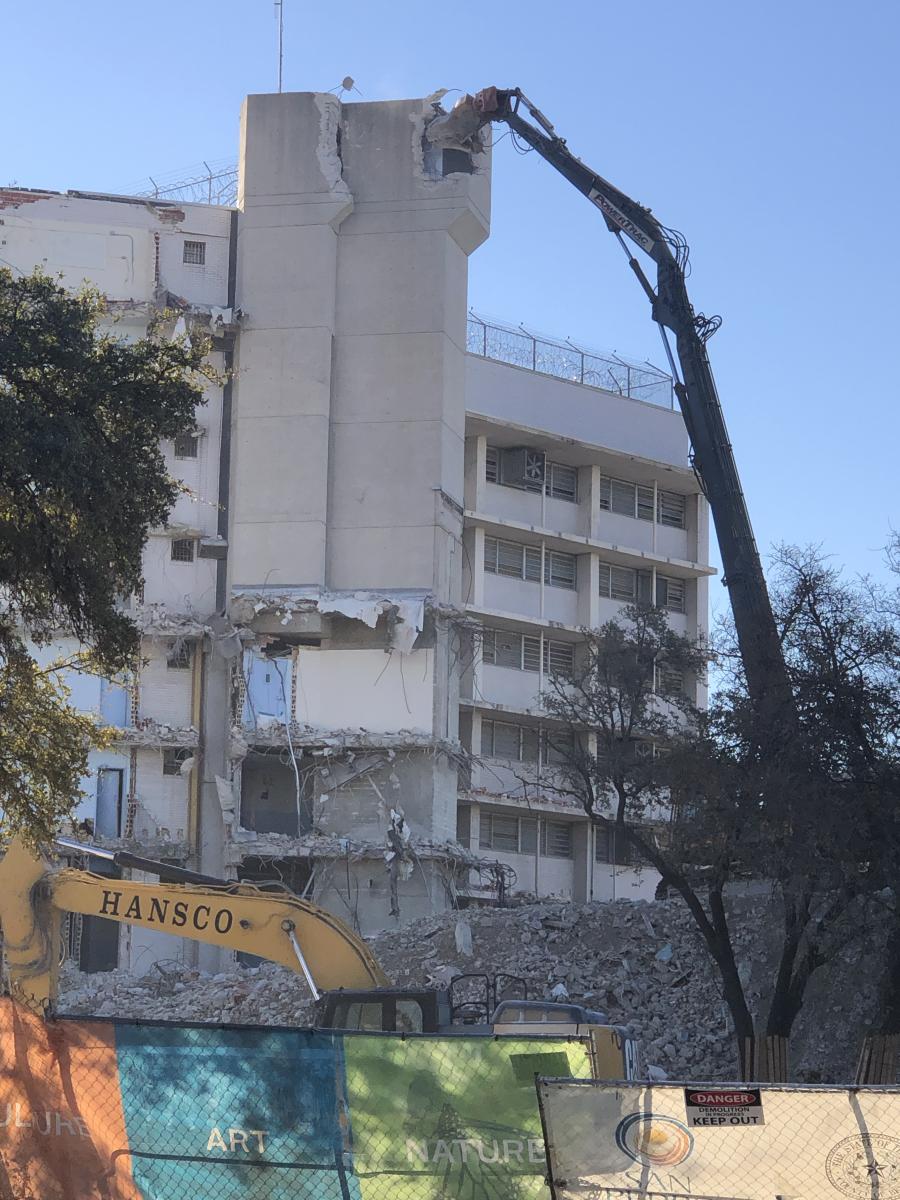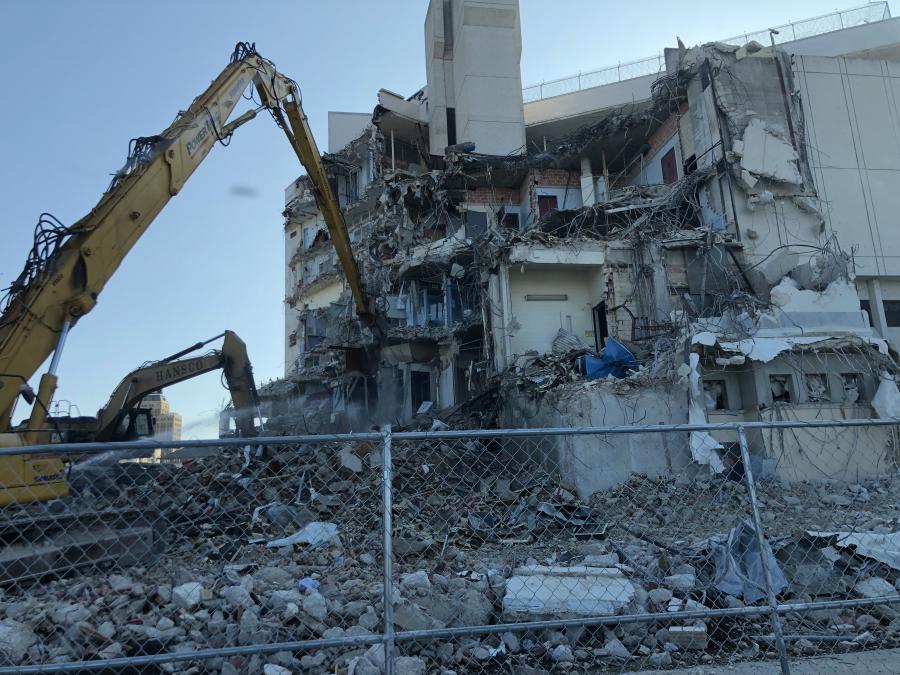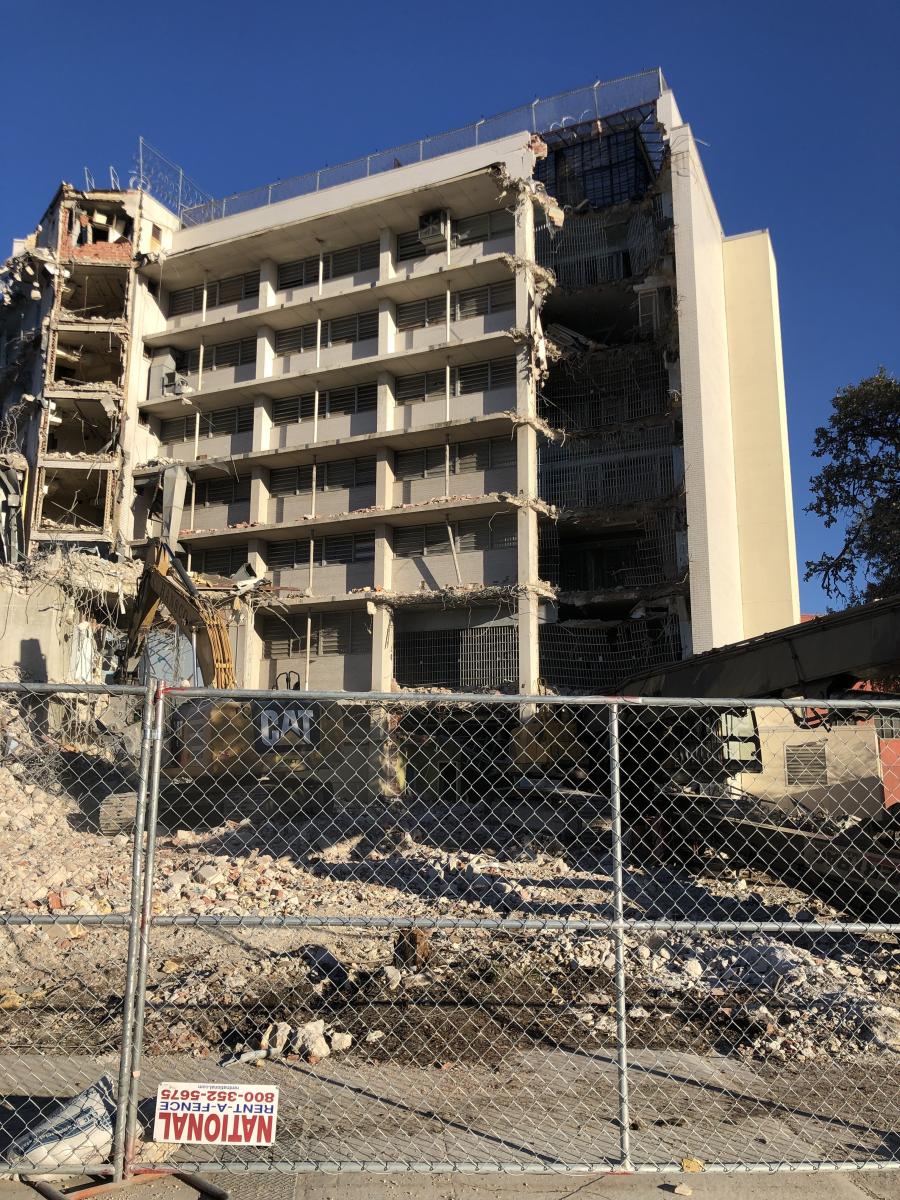Crews from Hansco Inc. demolished the former Bexar County Jail in downtown San Antonio to make room for the University of Texas at San Antonio’s (UTSA) $161 million Innovation, Entrepreneurship and Careers Building (IECB), which is expected to commence construction later this summer.
Construction on the University of Texas at San Antonio's (UTSA) $161 million Innovation, Entrepreneurship and Careers Building (IECB) is expected to start soon on the site of the former Bexar County Jail in downtown San Antonio after crews from Hansco Inc. recently demolished the existing structure.
The 250,000-gross-sq.-ft. structure at 622 Dolorosa St. is being funded via fundraising and a request for support through Tuition Revenue Bonds and the UT System. The site was purchased from Bexar County.
Demolition Process
The former jail had a triangular center core with three wings – one on each side. The concrete and steel structure, which was between 6 to 8 stories tall, was taken down using excavators with high reaches.
Dana Delao, Hansco's project manager, and Shane Hans, Hansco's owner, oversaw the demolition and were able to study some of the drawings and plans for the structure (built in 1960) which showed the floor footprints and the types of materials that were used for the construction.
"It was determined to start at the top and process the concrete structure with a processor at the end of a high-reach excavator to crush the concrete," said Delao. "We started on the edge of one of the wings and worked inwards towards the center core. Once the first wing was torn down, we moved over to the next one and so on. Once the wings were dealt with, we were able to attack the core."
Two high reach excavators were used – a Volvo 480 with an 86-ft. reach and a Komatsu 400 with a 96-ft. reach. Also utilized on-site was a Cat 330 Track loader and a various Cat skid steers.
The high reaches were placed on pads, built up by using debris, to extend their range to access the upper floors.
There were few challenges.
"It was a very uniform structure from top-to-bottom," said Hans. "The higher floors were a little more of a challenge then the lower floors, but all went well and it was pretty much the same thing for each floor. We first demolished some of the lower structures that branched off from the some of the wings to secure the debris for the pads. On the top there was also a penthouse where all the elevator equipment was place, which was challenging. The top area also contained some outdoor facilities with gates and fencing. We safely brought that material down."
While there was no basement level, there was a 4-to-5-ft. crawl space under the jail, built on piers, that had utilities running through it. This area was filled using some of the concrete debris.
Before the demolition could begin, though, the site had to undergo an asbestos abatement operation, along with the shutting down of the gas and electric services.
"We worked with the county and the City Public Service to get the electricity and gas disconnected and with the general contractor hired by the county, Sundt Construction Inc., to isolate the water and provide a connection for water for dust control," said Hans.
"It took about a month of coordinating and scheduling to get all the prep work done and to prepare the equipment," said Delao. "It also gave us time to move forward with the asbestos abatement that was required before demolition. It was throughout the building. It was a difficult operation. We were contracted to do a survey of the asbestos and other materials because one had not been done in years.
"Considering the type of building that it was, it was awfully hard to get access to a lot of the areas," he added. "In the middle of the abatement, we found additional materials which were enclosed behind solid walls, chases and ceilings. This was due to the type of secured building that was built and were hidden in different parts. We ended up getting a change order to remove the additional materials, which went fine."
The abatement operations followed all standard safety procedures, such as a full containment with negative air pressure and decontamination units.
The abatement operations were conducted via day shifts, as was the demolition itself, and the asbestos and other materials were transported to one of the two landfill sites authorized to accept asbestos materials.
"The prep work was pretty minimal," said Delao. "The city handled all of the disconnections. We divided the project into phases – the environmental phase and the demolition phase, which took about four months."
"Hansco was introduced to this project through our working relationship with Sundt Construction on the San Pedro Creek project," said Delao. "We are working under Sundt-Davila to perform demolition services for some bridges and several buildings being affected with the creek work. This creek project is a multi-year project which involves upgrading a naturally spring fed creek, which runs through downtown. This creek, through the downtown portion of it, has served more of a drainage system than what is normally thought of as a creek. The project involves turning the creek into a lineal type walking path park.
"The project also gave the city an opportunity to upgrade road bridges, sidewalks and utilities that crossed the creek," he added. "Part of this project runs just adjacent to the east of the jail building demolition with two road bridges undergoing replacement during some of the jail demolition. This creek project is a collaboration of the city of San Antonio, Bexar County and the San Antonio River Authority, which oversee our water ways through San Antonio.."
Hans noted that the crews had had plenty of space to conduct their operations, including sites for debris, field offices and equipment.
"On one side there was a historic structure, the Casa Navarro House, originally constructed in the 1950's – a rock home with a rock wall, [which was built over time to match the rock on the house], around it about 25 to 30 feet away."
Dust and noise issues were handled efficiently and rapidly.
"It was a little challenging at times with the dust due to windy days," said Delao. "We had water jets on the high reaches, close to the processor. This let us spray water all the way down to the base. Noise was not much of an issue. Hansco constructed a wooden wall against and over the rock wall to aid in deflecting any possible debris from hitting the rock wall. The Casa Navarro House is a tourist attraction, and they vacated this site during the demolition just to be safe and to avoid the noise and dust situations."
In addition to Hans and Delao, who have managed many projects together, there were seven crew members on-site. The subcontractors consisted of multiple heavy and light machine operators with many years of experience for safely demolishing the structure and various labor to aid with processing metals for recycling and directing truck traffic in and out of the construction site.
"The guys put in an excellent effort," said Hans. "Some of them have been with the company for 15 to 20 years and we put a lot of faith in their workmanship. Relations with the county were real good. We worked with them on several major projects and have a good rapport with them."
All the concrete and steel was sent to recycling centers for processing.
"The only thing that went into the landfill was a minimal amount of soft trash," said Hans, who noted that the glass and other interior materials were not removed prior to the demolition. "As material came down, we did everything we could to remove large pieces of steel that we could get off the debris piles and place in trucks and dumpsters. Once the main structure was down to the foundation, we were able to process the concrete and take out the fine, smaller pieces of metal."
Material was at times placed in dumpsters before being transferred to dump trucks. The steel was sent to a recycling facility about a mile away and the concrete to a facility about 15 miles away.
Equipment repairs were dealt with rapidly, as Hansco had an on-site mechanic.
"There's a lot of challenges with high reach equipment and all the different multiple points of contact as far as hoses and hydraulic leaks that we had to deal with," said Hans, "and the wear and tear on the processor teeth, which was to be expected."
The jail was only 15 miles away from Hansco's ofiice and yard, which helped to ensure that repairs could be done rapidly and that sending equipment to the site presented no problems. Only the high-reach excavators had to be disassembled for transport.
The jail, Hans pointed out, was very solidly constructed.
"You always change means and methods when taking on a project," he said. "There is nothing that is atypical in this industry. You can formulate a game plan, but during the execution of it, you may vary off the original plan depending on what's working and what is not."
Hansco purchases and rents equipment from HOLT CAT in San Antonio and Romco Equipment for Volvo machinery.
"We use a lot of Volvo and Cat equipment," said Hans. "Almost all of equipment is under warranty."
Building Background
The IECB, according to the university, "is a critical element in the university's strategic plan, connecting the Downtown Campus and School of Data Science to private business and technology entrepreneurs downtown. The building also will support programs that enhance the development of marketable skills of students in work settings as a part of the Classroom to Career Initiative, preparing them for careers in business, technology and its applications, and independent small business development. The IEC Building will put student innovators and entrepreneurs in the heart of the city's technology corridor and provides a collision space with mentors, coaches and other creative thinkers in the ecosystem. The downtown incubator and accelerator will be uniquely positioned to provide access to UTSA research and academic assets, and to community innovation and entrepreneurship mentors, capital and business developers."
The eight-story jail, which housed up to 600 prisoners, sat on a 2.6 acre site. The demolition operation lasted from October 2020 to last February. Until 2019, the building was owned by the CEO Group, which ran a correctional facility that had, since 1987, housed federal pretrial inmates.
In addition, the UTSA held a virtual groundbreaking ceremony for the $90 million School of Data Science and National Security Collaboration Center (SDS–NSCC) on Jan. 25 for the first new building of several that will be part of its Downtown Campus expansion. The 167,000-sq.-ft, six-story structure on 506 Dolorosa St. will sit along San Pedro Creek east of IH-35 and anchor the university to San Antonio's prospering high-tech corridor. The plan is for the campus to serve as a catalyst for economic and community investment in the San Pedro Creek area.
This building at 506 Dolorosa, expected to achieve substantial completion in July 2022, is on the property to the east of the jail site that the UTSA purchased from the city of San Antonio.
The construction projects advances the university's goal to secure national recognition as a research-intensive institution and bolster San Antonio's national standing as Cyber City USA.
"For more than 20 years UTSA has been a pioneer in cybersecurity and also now offers best-in-class programs in data science, cyber manufacturing, cloud computing and artificial intelligence," said UTSA President Taylor Eighmy. "This new transdisciplinary building, which is deeply connected to the economic well-being of San Antonio and will house the first School of Data Science in Texas, will enable UTSA to prepare students for the high tech jobs of the future and to grow its ecosystem of government, industry and academic partners tackling society's grand security challenges."
The SDS–NSCC will have nearly 86,000 sq. ft. of classroom, laboratory and research space for the 6,500 data science students. The UTSA expects that students will be attending classes in the building in 2022. It will be home to 70-plus faculty members in cybersecurity, cloud computing, data analytics and artificial intelligence and the university's computer science, computer engineering, statistics and data sciences, and information systems and cybersecurity departments, as wells its Open Cloud Institute.
The SDS–NSCC is being funded via $75 million from The University of Texas System Permanent University Fund and a $15 million gift from San Antonio business leader Graham Weston.
"The UTSA School of Data Science will be at the heart of the thrust of new innovation over the coming decades," said Weston. "We can be a national leader in this field — one of the few schools that really separates itself from the pack. This is going to change the face of what UTSA is, and my prediction is UTSA is going to be famous around the country and the world in data science and cybersecurity.
Whiting-Turner | Jacobs | Overland designed the SDS–NSCC and is constructing it. Last December, Whiting-Turner began removing the parking lot at the property. CEG
Irwin Rapoport
A journalist who started his career at a weekly community newspaper, Irwin Rapoport has written about construction and architecture for more than 15 years, as well as a variety of other subjects, such as recycling, environmental issues, business supply chains, property development, pulp and paper, agriculture, solar power and energy, and education. Getting the story right and illustrating the hard work and professionalism that goes into completing road, bridge, and building projects is important to him. A key element of his construction articles is to provide readers with an opportunity to see how general contractors and departments of transportation complete their projects and address challenges so that lessons learned can be shared with a wider audience.
Rapoport has a BA in History and a Minor in Political Science from Concordia University. His hobbies include hiking, birding, cycling, reading, going to concerts and plays, hanging out with friends and family, and architecture. He is keen to one day write an MA thesis on military and economic planning by the Great Powers prior to the start of the First World War.
Read more from Irwin Rapoport here.
Today's top stories

























